10 Rare Ancient Roman Coins That Collectors Are Dreaming Of
Posted onFrom portraits of powerful emperors to depictions of mythological figures, it is easy to see why Roman coinage captivates numismatists. While the world of Roman numismatics is vast and complex, navigating its intricacies is made simpler with our list highlighting gold and silver rare Roman coins’ value and history. This piece will discuss:
- The most valuable rare Roman coins.
- The factors contributing to the rarity of Roman coinage.
- Sourcing gold rare Roman coins online.
Watch this informative video to learn more about ancient Roman coins:
Rare expensive Roman coins
Windows into the past, Roman coins, often discovered in Roman coin hoards, offer invaluable insights into the political, cultural, and economic landscape of ancient Rome. Bearing the likeness of emperors, gods, and symbols that reflect the values and aspirations of people of the time, Roman coinage is a journey through the annals of ancient civilization.
1. Galba Aureus: a highly coveted rare Roman coin.
A numismatic treasure created by the mint of Rome during the brief reign of emperor Servius Sulpicius Galba in AD 68-69, this aureus is sought after for its intrinsic value and historical significance. Aurei, emblematic of the late Roman Empire, were gold coins originally worth 25 silver denarii. Like all aurei, the Galba aureus was crafted of gold nearly 24 karats pure, boasting over 99% purity.
Featuring a design of Galba’s bust on the obverse and a female figure holding a patera and cornucopia on the reverse, this coin marked a pivotal moment in Roman history. It signaled the end of the Julio-Claudian dynasty and the start of the tumultuous Year of the Four Emperors. A shining example of an answer to the question “Are authentic Roman coins rare?”, any collector would be fortunate to have the Galba aureus grace their collection.
Roman Empire Galba Aureus
- Metal: Gold
- Year: AD 68 – 69

2. Augustus Aureus: one of the rarest Roman coins.
Struck during the reign of emperor Augustus, this aureus coin is a masterpiece of craftsmanship and symbolism. Minted in Pergamum, the coin features the profile of Augustus on the obverse and an image of a Capricorn on the reverse. The Capricorn, a hybrid creature with the body of a goat and the tail of a fish, held significant cultural importance in Roman society as it represented strength, resilience, and determination. Its image on this coin serves to convey the emperor’s connection to divine forces and his ability to ensure stability and prosperity for the empire.
Beyond its exquisite design, the Augustus aureus commands considerable value among collectors thanks to its historical importance. Augustus’ profound impact on Roman history is evident in the multitude of Roman coins, rare pieces uncovered in discoveries such as this, serving as a testament to his enduring legacy.
Augustus Aureus
- Metal: Gold
- Year: 19 BC – 18 BC
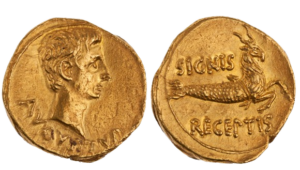
Photo by American Numismatics Society
3. Brutus Aureus: a rare Roman gold coin of great value.
Another one of the most coveted rare Roman gold coins, the Brutus aureus immortalizes one of the most infamous figures in ancient history, Marcus Junius Brutus. Made by the military mint accompanying Brutus in western Asia Minor or northern Greece, this gold coin portrays Brutus on the obverse and an emblem of absolute military triumph – a combined army and naval trophy – on the reverse.
The Brutus aureus holds profound significance as a symbol of resistance against tyranny and a harbinger of the Roman Republic’s demise. Its rarity and historical resonance render it highly desired by collectors.
Brutus Aureus
- Metal: Gold
- Year: 42 B.C.E.
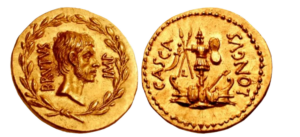
Photo by Numismatic News
4. EID MAR Denarius: among the rarest Roman coins in existence.
When it comes to sky-high rare Roman coin values, few can compete with the EID MAR Denarius. Otherwise known as the Denarius of Brutus, this coin offers a window into one of the most dramatic events in Roman history, the assassination of Julius Caesar on the Ides of March.
Brutus commissioned the minting of the EID MAR coin in both gold and silver to commemorate Caesar’s downfall. With Brutus’ profile on one side and two daggers, representing Brutus and Cassius, on the other, the coin was made to symbolize defiance against tyranny and captivates collectors today.
EID MAR Denarius
- Metal: Silver
- Year: 42 BC
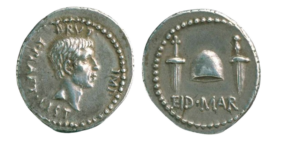
Photo by The Fitzwilliam Museum
5. Titus Colosseum Sestertius: a historically significant rare Roman coin.
A testament to the grandeur of ancient Rome and the magnificence of the Colosseum, this coin is a formidable answer to the question “How rare are Roman coins?”. This extremely rare bronze sestertius was minted during the reign of emperor Titus, who oversaw the completion of the Colosseum and its inaugural games.
The stunning coin features an image of the majestic amphitheater, symbolizing the power of the Roman Empire, on the reverse and the profile of Titus on the obverse. Today, it remains a cherished emblem of ancient Roman architectural innovation.
The Titus Colosseum Sestertius
- Metal: Bronze
- Year: AD 80 – 81
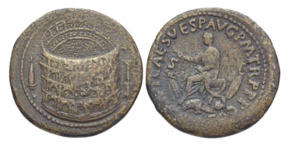
Photo by Classical Numismatic Group
6. Mark Anthony & Cleopatra Denarius: one of the most legendary silver rare Roman coins.
Another iconic coin that collectors wondering “Are Roman coins rare?” will appreciate is this denarius. Struck in silver, this rare piece serves as a tangible artifact of the legendary romance between the Roman general Mark Antony and the queen of Egypt, Cleopatra.
Commissioned by Mark Anthony after his conquest of Armenia, the coin’s obverse features a right-facing portrait of Mark Anthony, while the reverse shows the bust of Cleopatra. This striking denarius pays homage to the famous couple’s powerful partnership, immortalizing one of history’s most intriguing love stories.
Denarius of Mark Anthony and Cleopatra
- Metal: Silver
- Year: 32 BC
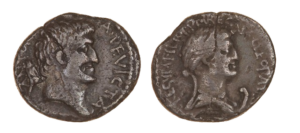
Photo by Museums Victoria
7. Nero Sestertius: a gem among the rarest Roman coins.
A list of rare expensive Roman coins would not be complete without the Nero sestertius. Often referred to as the Port of Ostia sestertius, this numismatic marvel is renowned for its intricate design. Struck in bronze, this coin uniquely features a detailed depiction of the Port of Ostia, a vital harbor city near Rome, on the reverse. The harbor scene includes ships, lighthouses, and warehouses, showcasing the bustling maritime activity of ancient Rome and unparalleled coinage craftsmanship.
The Nero sestertius holds great value for collectors, not only for its undeniable artistic merit but also for its historical importance. Through its meticulous portrayal of emperor Nero’s ambitious building projects, it offers a tangible connection to the grandeur and engineering prowess of ancient Rome.
The Nero Port of Ostia Sestertius
- Metal: Bronze
- Year: AD 62 – 68
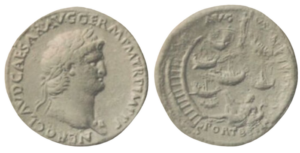
Photo by Numista
8. Julius Caesar Portrait Denarius: one of the rarest Roman emperor coins.
Depicting one of history’s most influential figures, this Julius Caesar denarius is a quintessential representation of ancient Roman coinage. Collectors especially prize this particular coin as it was minted during Julius Caesar’s lifetime and he was the first living person to appear on Roman coinage. This offers a tangible link to the ancient emperor.
What makes this coin even more unique, and therefore valuable to collectors, is that, unlike most rare Roman coins depicting Julius Caesar from later periods, this portrait clearly highlights Caesar’s advanced age by showing his wrinkled skin.
Portrait of Julius Caesar Denarius
- Metal: Silver
- Year: 44 B.C.
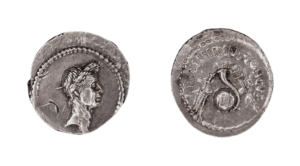
Photo by The Art Institute of Chicago
9. Valerian Antoninianus: the rarest Roman coin of an ill-fated emperor’s rule.
As far as rare ancient Roman coins are concerned, the Valerian Antoninianus is a stunning piece. A silver coin known for the distinctive crown worn by the emperor on its obverse, it pays tribute to Valerian’s brief but impactful rule. The coin’s reverse is adorned by different mythological motifs, such as the depiction of the Roman sun god Sol, adding to its allure.
The coin’s exquisite blend of artistic craftsmanship and symbolic imagery reflects the intricate narratives woven into ancient Roman coinage. This, along with its beauty, is the main reason why it is greatly prized by collectors to this day.
The Antoninianus of Valerian
- Metal: Silver
- Year: AD 253 – 260
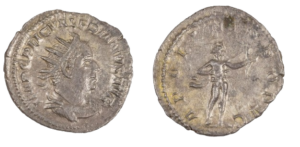
Photo by Yale University Art Gallery
10. Diocletian Follis: one of the most rare bronze Roman coins.
One of the most important bronze rare Roman coins is the follis of Diocletian. Minted in Rome, this remarkable coin from the late Roman Empire was a key monetary unit of the time. The follis was introduced by Emperor Diocletian in an effort to reform the Roman economy and stabilize the empire. With its standardized weight and size, it provided a more reliable medium of exchange compared to the debased coinage that preceded it.
Today, the follis of Diocletian is valued by numismatists and historians alike for the insights it provides into the economic dynamics of the late empire.
The Follis of Diocletian
- Metal: Bronze
- Year: AD 298 – 299
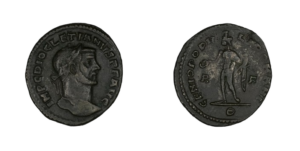
Photo by The Art Institute of Chicago
See more rare Roman coins for sale in Blanchard’s extensive selection.
Where to buy rare coins
Roman coinage epitomizes the rich tapestry of ancient history, offering collectors tangible connections to a civilization of unparalleled grandeur. To embark on your journey into the world of rare Roman coins or add to your collection, visit Blanchard and tap into the expertise of their seasoned team for guidance. Do not hesitate to contact Blanchard’s experts with questions about rare Roman coins price and more.
Want to read more? Subscribe to the Blanchard Newsletter and get our tales from the vault, our favorite stories from around the world and the latest tangible assets news delivered to your inbox weekly.







